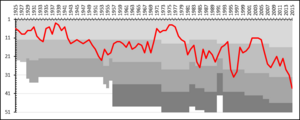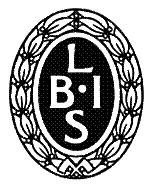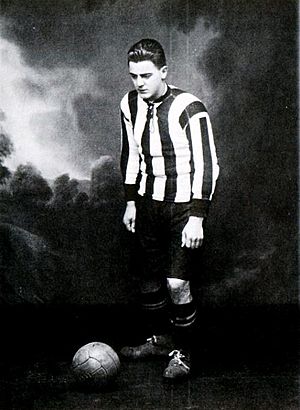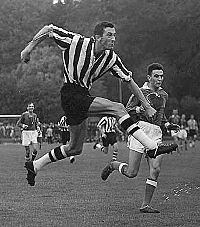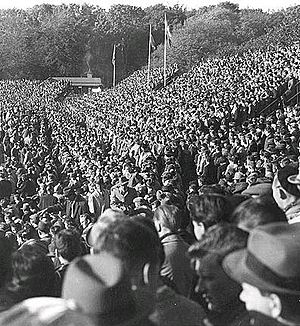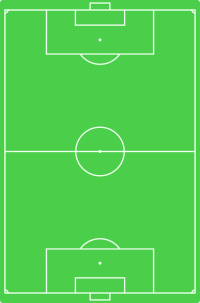Landskrona BoIS facts for kids
 |
|||
| Full name | Landskrona Boll och Idrottsällskap |
||
|---|---|---|---|
| Nickname(s) | Di randige (The Striped Ones, in Scanian dialect) Skånes uruguayare (Scania's Uruguayans) |
||
| Short name | BoIS | ||
| Founded | 7 February 1915 | ||
| Ground | Landskrona IP, Landskrona |
||
| Capacity | 10,500 | ||
| Chairman | Anders Ekbladh | ||
| Manager | Billy Magnusson | ||
| League | Superettan | ||
| 2022 | 6th | ||
|
|
|||
Landskrona Boll och Idrottsällskap, often called BoIS, is a professional football club from Landskrona, Sweden. They play in Superettan, which is the second-highest football league in Sweden. The club was created on February 7, 1915, when two local Landskrona teams, IFK Landskrona and Landskrona BK, joined together.
Landskrona BoIS was one of the first twelve teams to play in the very first Allsvenskan season in 1924–25. Since then, they have played 34 seasons in Allsvenskan (the top league) and 54 seasons in the second-highest division. BoIS has won four medals in Allsvenskan: a "little silver" (for third place) in 1937–38, and bronze medals (for fourth place) in 1938–39, 1975, and 1976. They also won the national cup title in 1971–72.
Contents
Club History: Landskrona BoIS Story
How Football Started in Landskrona
One of the first sports clubs in Landskrona was GF Idrott, founded in 1882. Another early club was Landskrona Velocipedklubb, a cycling club. In 1893, they built a simple cycling track with a grass field in the middle. This field later became the first home ground for Landskrona BoIS.
Football was first shown to a larger audience in Landskrona in 1894. GF Idrott hosted an exhibition game between players from Malmö Velocipedklubb. About 700 people came to watch this exciting event.
Over time, GF Idrott's football section became less active. Another local team, Diana, became more popular, especially among working-class people. Not much is known about IFK Landskrona, the other team that merged to form BoIS. They mainly brought their strong players to the new club.
BoIS is Born: The Early Years
Diana and IFK Landskrona decided to merge on February 7, 1915. This created Landskrona BoIS. Diana's strong organization and IFK Landskrona's talented players made a powerful new team. Bror Nilsson, Diana's former chairman, became the first chairman of Landskrona BoIS.
Until 1924, the club played at the old cycling track, known as Banan. In July 1918, BoIS played their first international match against KFUMs Boldklub from Copenhagen.
Albin Dahl was the best player for Landskrona BoIS in these early years. He was the club's first player to compete in the 1920 Summer Olympics for Sweden. Albin played for BoIS from 1915 to 1921. His younger brother, Harry Dahl, also played for the club.
Joining the Top League: 1924–1942
In 1924, the new Landskrona IP stadium was built. This allowed Landskrona BoIS to join the first-ever Allsvenskan season. BoIS even became the first team to lead the Allsvenskan table after winning their first game 1–0 against IFK Norrköping. They finished their first season in 6th place.
Harry Dahl played for the club until 1932. He scored an amazing 334 goals in 410 matches, making him the club's all-time top scorer!
After Harry Dahl left, the team was relegated (moved down a league) in 1932–33. But they quickly got promoted back to Allsvenskan the next season. They even won their first medal, a "Little Silver Medal" (for 3rd place) in 1937–38. The next season, 1938–39, they won a bronze medal (for 4th place).
BoIS played in 17 of the first 18 Allsvenskan seasons, from 1924–25 to 1941–42.
Ups and Downs: 1942–1960s
The 1940s were a bit tougher for the club. They often moved between leagues, sometimes going up and sometimes down. In 1949, Landskrona BoIS reached the final of the Svenska Cupen, the national cup. They played against AIK in front of nearly 15,000 fans but lost 1–0.
In 1951–52, BoIS was relegated to the third-highest league. But they bounced back quickly, getting promoted to the second tier in 1953.
During the mid-1950s and 1960s, Landskrona BoIS tried many times to get back into Allsvenskan but didn't succeed. They played important qualification games in 1958, 1959, 1962, and 1968. In 1962, they almost made it, but a late goal in another match stopped them.
Hasse Persson was a big star player during this time, scoring 257 goals in 327 matches. Claes Cronqvist also played for the club in the early 1960s before moving to Djurgårdens IF.
The Golden 1970s: Success and Challenges
A very talented young player named Sonny Johansson joined Landskrona BoIS. He became a true legend, staying with the club for his entire 17-season career!
In 1970, BoIS had a very important game against rivals Helsingborgs IF. They won 1–0 in front of over 15,000 fans, which helped them reach the promotion qualifiers. After a tough series of games, Landskrona BoIS finally got promoted back to Allsvenskan in 1970, after 21 seasons away!
BoIS stayed in Allsvenskan for ten seasons during the 1970s. They won two bronze medals in 1975 and 1976, and the Swedish Cup in 1972. Sonny Johansson was a huge part of this success, scoring over 300 goals for the club. He was the highest-scoring player in Allsvenskan during the 1970s. Claes Cronqvist also returned to the club in 1971.
In 1978, the town's biggest employer, the Öresundsvarvet shipyard, was in trouble. The BoIS players showed their support by holding up a banner that said "Save the shipyards" before a game. This was a powerful message that got a lot of applause.
In 1979, something unusual happened. Both of the club's goalkeepers were injured. So, the goalkeeper coach, Rolf Nilsson, who was 46 years old, had to play! He became, and still is, the oldest player ever to play in Allsvenskan. BoIS won that game 3–2!
Tough Times and Comebacks: 1980s and 1990s
After the successful 1970s, BoIS was relegated from Allsvenskan in 1980. In 1984, they even dropped down to the third-highest league, which was a very tough time for the club.
In 1985, the team had a very low attendance at a home game, with fewer than 400 people watching. But BoIS fought hard and managed to win their regional league. They then won a penalty shootout in a qualification game to get promoted back to the second tier.
In 1993, under manager Conny Karlsson, Landskrona BoIS was promoted back to Allsvenskan after 14 years! However, they were relegated again in 1994 and faced big financial problems.
In 1997, the legendary striker Sonny Johansson returned to the club as manager. He immediately led the team back to the second tier. In 1999, Swedish football leagues were reorganized, and Landskrona BoIS secured their spot in the new national league, Superettan, after a thrilling 5–4 comeback win against Kristianstads FF.
Modern Era: 2000s and Beyond
In 2001, Landskrona BoIS was promoted to Allsvenskan again! In their first game back in 2002, they beat local rivals Helsingborgs IF 6–2 at home. They even led the league for a while that season. BoIS stayed in Allsvenskan until 2005.
Between 2006 and 2014, Landskrona BoIS played in Superettan. Famous Swedish footballer Henrik Larsson was the manager from 2009 to 2012. In 2014, the club was relegated again, meaning they celebrated their 100th birthday in the third tier.
After three years, BoIS returned to Superettan in 2018. They had a great start, including a 1–1 draw against Helsingborg IF in front of over 8,000 fans. But they were relegated again that summer.
In December 2020, the club managed to get promoted back to Superettan. They finished the 2021 Superettan season in a strong 6th place.
Club Ownership and Management
Landskrona BoIS is a non-profit organization, like most Swedish sports clubs. This means it's run by a board chosen by the club's members every year.
For its first 65 years, the club had very stable leadership, with only three main chairmen. This changed in the 1980s, but then Kenneth Håkansson brought stability back, serving as chairman from 1996 to 2014. He is remembered for the club's time in Allsvenskan from 2002–2005.
Club Officials
Coaching Staff
Home Grounds: Where BoIS Plays
The First Home: Banan (1915–1924)
Landskrona BoIS first played on a simple cycling track called "Banan" (meaning the track). Football was first introduced in Landskrona at this ground, which was built in 1893. It was the first home for Landskrona BoIS and the teams that merged to form it.
The Current Home: Landskrona IP (Since 1924)
Since 1924, Landskrona IP has been the home of Landskrona BoIS. The very first match at this stadium was between Landskrona BoIS and B 1903 from Denmark.
The first Allsvenskan match at Landskrona IP was on August 10, 1924. BoIS played against IFK Göteborg and lost 4–0.
The record for the most people at a game was 18,535. This happened on October 18, 1959, during a qualification match for Allsvenskan against Degerfors IF. For an Allsvenskan league game, the highest attendance was 17,697 against Malmö FF in 1975.
In 2013, there was a discussion about changing the stadium's natural grass field to artificial turf. However, supporters protested, and the local politicians decided to keep the natural grass.
Supporters and Rivalries
The biggest supporter club for Landskrona BoIS is called Black & White, started in 1993. They even publish a fan magazine called "Halvtid" ("Half Time"). Most of the club's supporters are from Landskrona itself, but fans also come from nearby towns like Svalöv, Eslöv, and Lund. There's even a group of supporters in Stockholm!
Main Rivals
Landskrona BoIS has had different main rivals over the years. Many supporters see Helsingborgs IF as their biggest rival. These two cities are close, and their teams have had a rivalry for a long time, going back to the early 1900s.
There's also a rivalry between Landskrona and Malmö FF, which started in the 1930s. During the successful 1970s, Malmö FF was definitely the main rival because Helsingborg wasn't in Allsvenskan then. Games between teams from Scania are called Skånederbyn. In a 2005 poll, most Landskrona supporters (64.6%) said Helsingborgs IF was the most important team to beat, followed by Malmö FF (26.9%).
Team Colors and Crest
For their first season, Landskrona BoIS wore black and white striped shirts with black shorts and white socks. These black and white stripes have become their traditional home colors.
Away shirts have usually been red tops with black shorts. But there have been some changes! In 2003, the away shirt was bright yellow with red shorts, like the Scanian flag. In 2012 and 2013, they even wore pink tops with white shorts to support breast cancer awareness. More recently, they've worn burgundy and light blue away kits. In 2021, they honored their nickname "Scania's Uruguayans" by wearing light blue, similar to the Uruguay national team.
Kit History
| Period | Kit manufacturer | Home shirt color(s) | Away shirt color(s) |
|---|---|---|---|
| 1989 | Black & White | Red | |
| 1990–1992 | Black & White | Red | |
| 1993–1999 | Black & White | Red | |
| 2000–2004 | Black & White | Red/Yellow | |
| 2005–2006 | Black & White | White, Black | |
| 2007–2011 | Black & White | Red | |
| 2012–2014 | Black & White | Pink/Red | |
| 2015–2017 | Black & White | Red | |
| 2018– | Black & White | Burgundy/Light Blue/Red |
Players
Current First-Team Squad
|
|
Players on Loan
|
Famous Players
Here are some notable players who have played for Landskrona BoIS:
- Played at least 100 matches for the club.
- Played for their national team while at BoIS, or started their career there.
- Made very special contributions to the club's history.
|
|
Players Who Played for Their National Teams
This list includes players who represented their national team at a senior level while playing for Landskrona BoIS.
 Albin Dahl (1919–1922)
Albin Dahl (1919–1922) Birger Dahlgren (1921)
Birger Dahlgren (1921) Harry Dahl (1923–1930)
Harry Dahl (1923–1930) Carl Huldt (1929)
Carl Huldt (1929) Svante Kvist (1929)
Svante Kvist (1929) Erik Linder (1929–1939)
Erik Linder (1929–1939) Fritz Lindfors (1929)
Fritz Lindfors (1929) Axel Johansson (1930)
Axel Johansson (1930) John Nilsson (1930)
John Nilsson (1930) Knut Hansson (1933–1938)
Knut Hansson (1933–1938) Curt Bergsten (1935–1938)
Curt Bergsten (1935–1938) Arthur Karlsson (1935)
Arthur Karlsson (1935) Henning Pettersson (1935)
Henning Pettersson (1935) Harry Nilsson (1938–1942)
Harry Nilsson (1938–1942) Erik Persson (1938–1942)
Erik Persson (1938–1942) Erik Andersson (1939)
Erik Andersson (1939) Claes Cronqvist (1971–1974)
Claes Cronqvist (1971–1974) Jörgen Augustsson (1976–1977)
Jörgen Augustsson (1976–1977) Sonny Johansson (1977)
Sonny Johansson (1977) Alexander Farnerud (2003)
Alexander Farnerud (2003) Indrek Zelinski (2003)
Indrek Zelinski (2003) Auðun Helgason (2003–2004)
Auðun Helgason (2003–2004) Antti Okkonen (2004–2006)
Antti Okkonen (2004–2006) Jonas Sandqvist (2005)
Jonas Sandqvist (2005) Kevin Amuneke (2005)
Kevin Amuneke (2005) Bobo Bola (2005–2008)
Bobo Bola (2005–2008) Alagie Sosseh (2010)
Alagie Sosseh (2010) Mohamed Ramadan (2015)
Mohamed Ramadan (2015) Saber Azizi (2016–2017)
Saber Azizi (2016–2017) Amr Kaddoura (2021–)
Amr Kaddoura (2021–)
Club Achievements
Landskrona BoIS has a long history in Swedish football.
- They have played 34 seasons in the Highest Swedish League.
- They have played 54 seasons in the Second Highest Swedish League.
- They have played 9 seasons in the Third Highest Swedish League.
The club has never played below the third-highest league in Swedish football!
League Success
- Allsvenskan:
- 3rd place, little silver (1): 1937–38
- 4th place, bronze (3): 1938–39, 1975, 1976
- Second division:
- Winners (10): 1933–34, 1943–44, 1945–46, 1947–48, 1957–58, 1959, 1962, 1968, 1970, 1993
- Runners-up (8): 1941–42, 1946–47, 1956–57, 1960, 1965, 1992, 1998, 2001
- Third division:
- Winners (4): 1952–53, 1985, 1997, 2017
- Runners-up (2): 2019, 2020
Cup Success
- Svenska Cupen:
- Winners (1): 1971–72
- Runners-up (4): 1949, 1975–76, 1983–84, 1992–93
- Skånska Mästerskapet:
- Winners (4): 1923, 1930, 1935, 1936
- Runners-up (1): 1926
- Distriktsmästerskapet:
- Winners (2): 2016, 2022
- Runners-up (1): 2015
European Competitions
Landskrona BoIS has also played in European football competitions:
| Season | Competition | Round | Club | Score | |
|---|---|---|---|---|---|
| 1972 | Intertoto Cup | GR | Eintracht Braunschweig | 3–0, 0–2 | |
| TJ ZVL Žilina | 2–2, 0–1 | ||||
| Vejle BK | 0–0, 2–1 | ||||
| 1972/73 | UEFA Cup Winners' Cup | 1R | Rapid București | 1–0, 0–3 | |
| 1974 | Intertoto Cup | GR | CUF Barreiro | 1–1, 0–1 | |
| Altay S.K. | 1–1, 1–1 | ||||
| Hammarby IF | 4–0, 2–1 | ||||
| 1976 | Intertoto Cup | GR | TJ Sklo Union Teplice | 1–1, 0–0 | |
| Kickers Offenbach | 1–2, 0–1 | ||||
| Grasshopper Club Zürich | 0–0, 0–1 | ||||
| 1977 | Intertoto Cup | GR | Slavia Prague | 3–5, 1–6 | |
| Legia Warszawa | 1–2, 0–1 | ||||
| BSC Young Boys | 2–1, 0–4 | ||||
| 1977/78 | UEFA Cup | 1R | Ipswich Town F.C. | 0–1, 0–5 |
Club Managers: A Look at Leadership
Here is a list of recent managers for Landskrona BoIS:
- (C) – Caretaker (meaning they temporarily took charge)
|
Managers Who Made a Difference
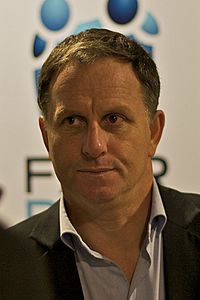
These managers are listed by their first season with Landskrona BoIS. They either won medals or promotions, or managed the team for at least 5 years.
| Name | Nation | Years | Honours |
|---|---|---|---|
| Karl-Erik Hult | 1970–1971 | Won Division II and got the team promoted to Allsvenskan. | |
| Rolf Svensson | 1972–1976, 1987–1989 | Managed for 8 years total. Won 1 Svenska Cupen, 1 silver medal, and 2 Allsvenskan bronze medals. | |
| Claes Cronqvist | 1983–1985 | Won 1 Svenska Cupen silver medal and promotion to Division 2. | |
| Sonny Johansson | 1990, 1997–1999 | Won Division 2 Södra and got the team promoted to Division 1 Södra in 1997. | |
| Conny Karlsson | 1991–1993 | Won 1 Division 1 Södra and promotion to Allsvenskan. Won 1 Svenska Cupen silver medal. | |
| Jan Jönsson | 2001–2004 | Finished as Superettan runners-up in 2001, getting the team promoted to Allsvenskan. | |
| Agim Sopi | 2016–2018 | Won 1 Division 1 Södra and got the team promoted to Superettan. | |
| Billy Magnusson | 2015, 2019– | Finished as Ettan Södra runners-up in 2019 and 2020, getting the team promoted to Superettan. |
Images for kids
-
Landskrona BoIS playing a qualification game to Allsvenskan in 1962 at home against AIK. Attendance 16.010.
-
Landskrona BoIS players at the home derby against Helsingborgs IF in 2003.
-
Daniel Nannskog became the topscorer in Landskrona BoIS, as well as in the whole Superettan league in 2001.
See also
 In Spanish: Landskrona BoIS para niños
In Spanish: Landskrona BoIS para niños


